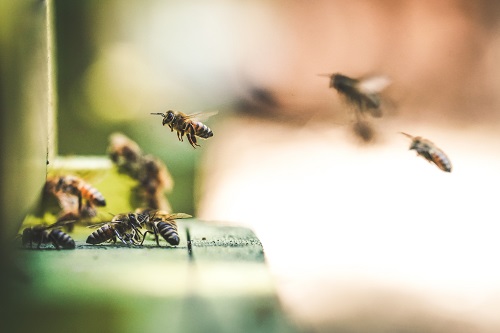Indoor Water Plants and Herbs That You Can Grow All Year Long
We’ll let you know a secret of a trouble-free way to grow plants in your indoor spaces as well as outdoors. Yes, you heard us right! You can cultivate your plants by replacing soil with water as the growing medium. This great and inexpensive way of growing plants in water is called hydroponics.
Growing a plant in water is relatively easy as compared to growing it in soil. This is a good tactic for beginners and even small kids who are developing a passion for gardening, water can be a great medium for the propagation of plants also. Another perk of growing indoor plants is having your own kitchen garden. There are numerous herbs that propagate and thrive so well in water that you would question yourself as to why you were hesitant in growing them before.
The only hitch that we see in this method is that it is relatively slow-growing as compared to growing plants in soil but hey, no worries here as it will give you equally lush foliage and green year-round.
This article is about growing your indoor plants in the water year-round without having to worry about the kind of soil to use and the issues related to it like how moist or wet it needs to be and many more. We will be discussing how this magic happens and a list of indoor growing plants that can flourish well without soil and in water only.
The Kind of Containers to Use
Most people who are familiar with growing their indoor plants with water use empty recyclable glass bottles as containers. Well, you should not be constricted to using only glass bottles for this method. Any container with good depth can be used but make sure that metal containers are avoided. There is a chance of fertilizers reacting with the metals and eventually damaging the plant’s roots. Using dark, dense (prevents algae from forming) and waterproof containers should be a preference.
The Kind of Water to Use
We suggest using a concoction of water and water-soluble fertilizers (in a one-third ratio of the manufacturer’s recommendation) for growing plants this way. Don’t forget to add a pinch of powdered charcoal or small chunks of it to prevent the water from getting all dirty and reeking. We also propose adding a base material to the water like florists foam, gravel, chips, pebbles, etc for decorative as well as support purposes.
Fancy Plants That Grow Well in Water
Now that we have covered the preliminary steps, it’s time to go over a list of plants that will be your best bet and will thrive well in water. These fancy plants can add to your beautiful green collection while giving you numerous other benefits.
1. Pothos
The number one plant that tops our list is the Pothos. You might be familiar with this plant because it is found in almost every plant-loving home where it is grown in vintage green wine bottles. It is a trailing vine with heart-shaped leaves that have a marbled pattern on them. The reason it is number one on our list is because of the relaxed nature of this plant. So easy to grow in soil and even easier to grow in water. It can do well in bright indirect light as well as complete shade or dark.
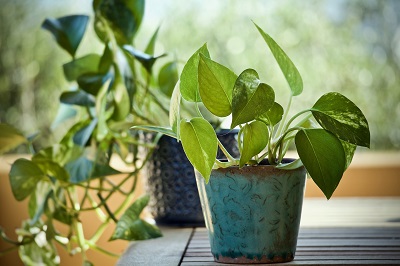
Pothos can be very easily propagated in water by simply taking a stem cut with healthy leaves from the mother plant and rooted in a new container with water. These plants are considered toxic for kids and pets, although not proven fatal but can cause vomiting if indigested. Other than that, it is also a good air purifier.
Tip: If your Pothos have white variegation, it is time you provide it with light as it might not be doing too well in shade.
Recommended Article- How I like to decorate my home with Pothos AKA Devil’s Ivy
2. Wax Plant
An extremely attractive house plant that has big waxy oval-shaped leaves trailing along the vine. It occasionally blooms with white star-shaped flowers that have the sweetest fragrance. Just provide them with high humidity levels and indirect bright light and they are good to go. One of the longest living plants that can be your best friend if you are a beginner. We recommend using rainwater for growing Hoya wax plants (commonly called as such). If your plant is not doing well, you might want to change its light requirements. Just don’t put them in the direct afternoon sun as it may burn the foliage.
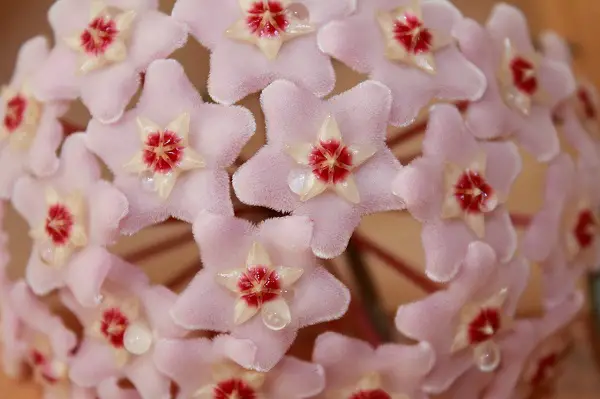
Particularly known to be one of the most easily propagated plants in water, simply cut the stem with healthy leaves and place it in a new jar with water. Just don’t submerge the leaves and keep them in a draft-free spot. Spring/summer is the most suitable time for propagation as the growth rate is very high at that time. Change the water when turned murky. Wax plants are non-toxic for animals and humans.
3. Philodendron
An all-rounder plant that is specifically good for keeping indoors while thriving well in water. It is a flowering plant that has a very low maintenance profile and has no pest contamination issues. Climbing philodendrons have dark-colored heart-shaped leaves while the standing philodendrons have larger leaves in comparison. These are preferred house plants because of their easy, adaptive nature. They can flourish well in low light and in all water conditions.
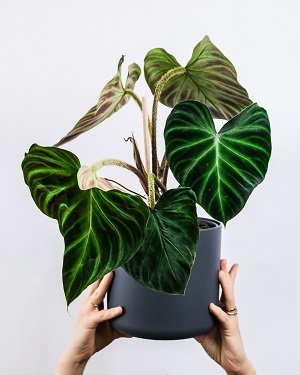
Rooting a stem cutting with leaves is the easiest way to propagate. This can be done in water as well as soil. Also known for their air-purifying qualities, these plants are very effective for reducing air pollution. These are highly toxic plants that can prove to be fatal. So if you really like adding them to your indoor space, place them at a spot where they are unreachable to pets and kids. Be particularly watchful if you have a climbing type at home.
Have you ever considered starting your own vertical garden? Here is a list of hanging flower plants that will brighten up your garden.
4. Arrowhead Plant
The name comes from the shape of the unique leaves. Arrowhead plants can be easily and successfully grown in water instead of soil. It remains green throughout the year. Find a spot that gets indirect bright light and the warmth of the sun. A window sill is a perfect place to put your vase of arrowhead plant where it can get its share of indirect sunlight.
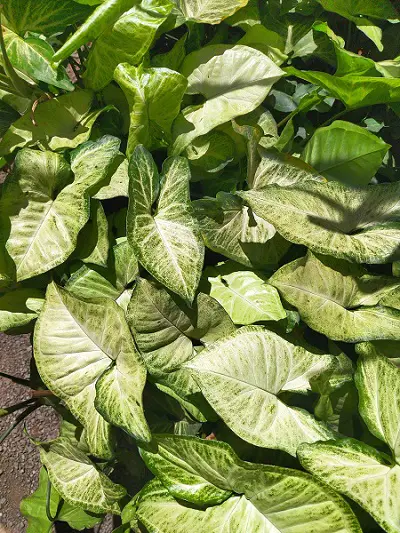
Propagating this plant is also very easy. Simply take a stem cutting from a healthy plant with a few leaves and place it in a jar with water. Adjust the water level such that the leaves do not touch the water. Change of water after a week’s time to a fresher one without salts and chlorine is healthy for the plant.
If your plant leaves are turning white, there may be a case of pest infestation at your hand. To make sure, move the plant leaves a little. If you notice tiny whiteflies around it, then a spider mites infestation is confirmed. Well, you might think where you went wrong? The answer is simple; these pests infestation is a result of low humidity around the indoor plant. This plant is toxic so we recommend being careful when placed in a house where there are pets or little humans.
5. Dumb Cane
Dumb cane plants can be easily rooted and grown in water instead of soil. This plant with its most unique leafed foliage is a statement in itself. It has extremely broad leaves that serve ornamental purposes and thrives best in bright indirect sunlight, although part shade will work fine for the plants as well. It is a flowering plant that seldom blooms when kept indoors. Dumb cane is a good air purifier and takes away a hefty amount of toxins from the air.
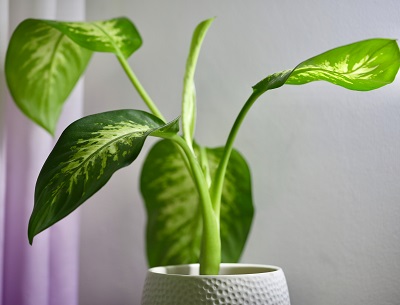
These plants can be easily propagated in water via the stem cutting method. If your stem cutting is from a plant that is cultivated in water, then it won’t have any issues while settling and start growing. Dumb cane is highly toxic and if chewed, it can have immediate consequences. We strictly suggest not keeping this plant in reach of pets or small kids. Don’t grow them in an aquarium as these plants are poisonous and may result in the death of the fish if nibbled upon.
Did You Know? If bitten or chewed, it can cause temporary speechlessness. That is how the plant got its name!
Herbs
Growing herbs in water is almost as easy as the ABCs. Now your dream can finally come true of having your kitchen garden and you can have the freshest of the greens any time you want. Here is a list of herbs that can be easily cultivated in water jars in your kitchen.
1. Basil
A culinary herb that is used in cuisines worldwide, basil can be effortlessly cultivated in water. It has great antioxidant properties and not to mention the wonderful aroma and flavor it brings in the food. It can take 8 straight hours of direct sunlight and can even thrive in indirect bright light. Give it a warm surrounding temperature and chlorine-free fresh water and it will show you how much it flourishes. It can be easily propagated through rooting the stem cutting in water.
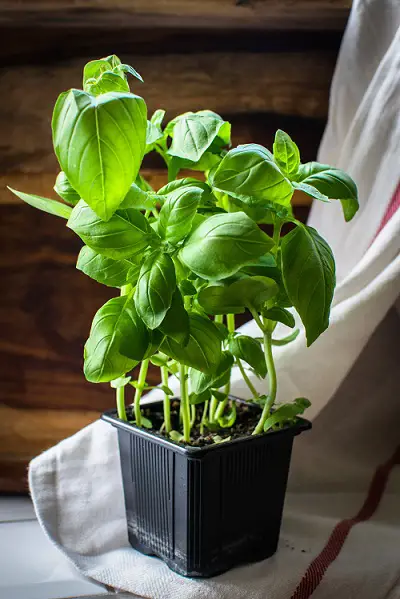
2. Mint
How can you not rave about mint and its soothing fragrance? An excellent antioxidant that is used vastly in food and known for its medicinal properties, it can cure heartburns, upset stomachs, and unclog nasal congestion.
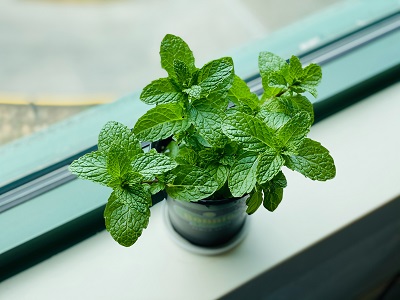
Mint is also a great addition to your kitchen garden and can be easily grown in a mason jar filled with water. You can use net cups (easily available in local nurseries) and put them in water to grow mint. Place it on the sill of the kitchen window that receives 4-6 hours of full sun. Change water after every three to four days if you want to grow them without fertilizers.
3. Rosemary
Don’t forget to put a stem or two of rosemary while braising your steak because man, that smells great! Not only for your steaks but exceptional for your herbal tea, grow your own rosemary in your kitchen garden using water only. It has great medicinal value for re-growing your hair or your skin. You can easily propagate rosemary in water and can see the efficient results in 3-4 weeks. It needs warm temperatures to grow which can be easily sorted if the jar is placed in the kitchen. Generally, a newly propagated plant should be kept in filtered light but once it grows stable, it should receive at least 6-8 hours of sunlight. Grow them in chlorine-free freshwater or add fertilizers to the water to provide essential nutrients.

4. Oregano
Fresh oregano is a great antibacterial and fights various infections. It is also an antioxidant that can kill cancer-causing elements in the body and is also found helpful in lowering cholesterol levels. Some of the most common uses of oregano include using in pizza and pasta sauce. Growing oregano is easy especially via hydroponics. Trimming and pruning will give you even more lush foliage. Change water after 3-4 days while making sure that the roots don’t rot. Most of the variety of this plant should receive full sun but some can do well in part shade as well. Give it a warm and humid environment to grow. Similarly, you can propagate it via stem cutting while rooting it in a water jar or a container.
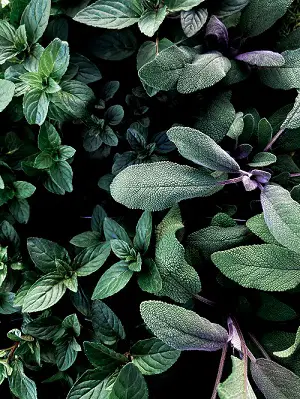
With this post on kitchen décor ideas and necessities, you can make your kitchen appear stunning.
5. Fennel
Fennel is a perennial herb with yellow flowers and feathery leaves that belong to the carrot family. Every part of this herb is edible, from the bulb to the flowers and the seeds. The seeds when dried up can be used as a spice that is very fragrant and has great medicinal values. It may improve symptoms of anemia as well. It has a licorice flavor and the stem has a celery-like texture. Fennel can be a great addition to your kitchen garden which you can grow in water. Give it 6-8 hours of sunlight and warm temperatures and you have a happy plant at your hands. It has bulbous roots like an onion. When propagating, cut a stem from right above the bulb while not damaging it. Submerge the stem in water making sure that water doesn’t touch the leaves.
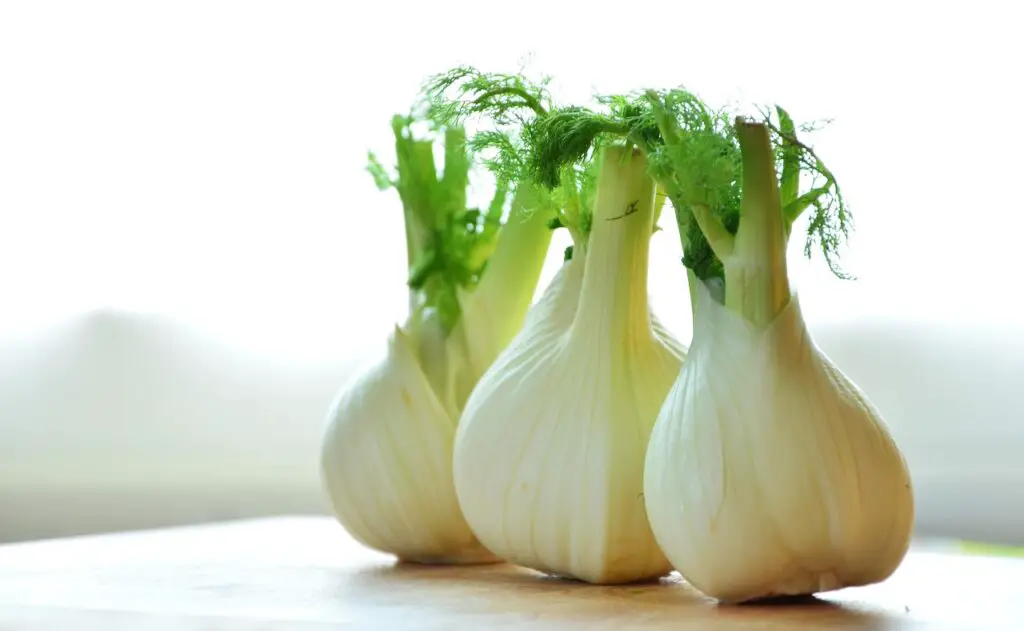
This method of growing plants in water is also pest and disease resistant and is a win-win situation for all. You don’t have to worry about forgetting to water your plants if you have a busy routine. Or if you don’t like the mess that working with the soil creates, then growing plants in water is your jam.
And since the secret is out now, it is your cue to become the gardener you always wanted to be and continue the zeal of growing plants year-round without it being tricky.
Recommended Article- Which is The Best Fertilizer for Garden Plants? Artificial or Organic, Which One to Choose?

